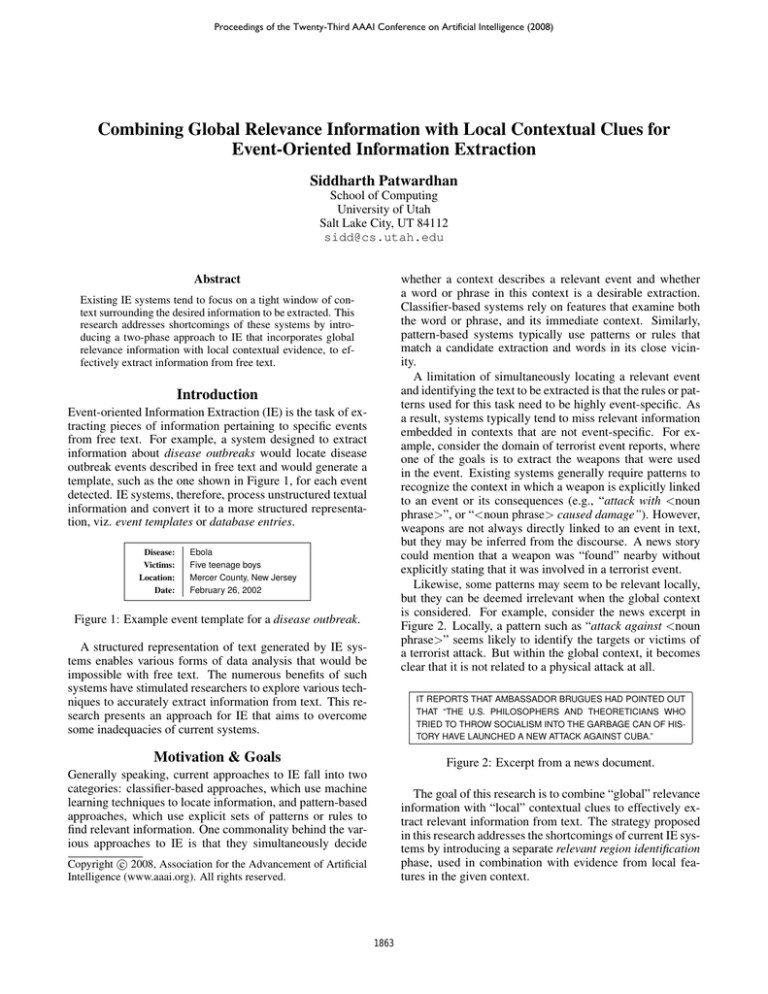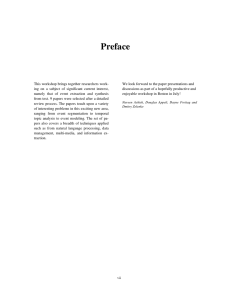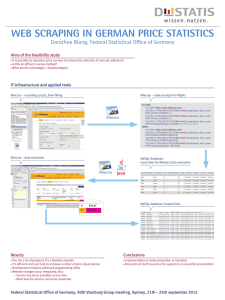
Proceedings of the Twenty-Third AAAI Conference on Artificial Intelligence (2008)
Combining Global Relevance Information with Local Contextual Clues for
Event-Oriented Information Extraction
Siddharth Patwardhan
School of Computing
University of Utah
Salt Lake City, UT 84112
sidd@cs.utah.edu
Abstract
whether a context describes a relevant event and whether
a word or phrase in this context is a desirable extraction.
Classifier-based systems rely on features that examine both
the word or phrase, and its immediate context. Similarly,
pattern-based systems typically use patterns or rules that
match a candidate extraction and words in its close vicinity.
A limitation of simultaneously locating a relevant event
and identifying the text to be extracted is that the rules or patterns used for this task need to be highly event-specific. As
a result, systems typically tend to miss relevant information
embedded in contexts that are not event-specific. For example, consider the domain of terrorist event reports, where
one of the goals is to extract the weapons that were used
in the event. Existing systems generally require patterns to
recognize the context in which a weapon is explicitly linked
to an event or its consequences (e.g., “attack with <noun
phrase>”, or “<noun phrase> caused damage”). However,
weapons are not always directly linked to an event in text,
but they may be inferred from the discourse. A news story
could mention that a weapon was “found” nearby without
explicitly stating that it was involved in a terrorist event.
Likewise, some patterns may seem to be relevant locally,
but they can be deemed irrelevant when the global context
is considered. For example, consider the news excerpt in
Figure 2. Locally, a pattern such as “attack against <noun
phrase>” seems likely to identify the targets or victims of
a terrorist attack. But within the global context, it becomes
clear that it is not related to a physical attack at all.
Existing IE systems tend to focus on a tight window of context surrounding the desired information to be extracted. This
research addresses shortcomings of these systems by introducing a two-phase approach to IE that incorporates global
relevance information with local contextual evidence, to effectively extract information from free text.
Introduction
Event-oriented Information Extraction (IE) is the task of extracting pieces of information pertaining to specific events
from free text. For example, a system designed to extract
information about disease outbreaks would locate disease
outbreak events described in free text and would generate a
template, such as the one shown in Figure 1, for each event
detected. IE systems, therefore, process unstructured textual
information and convert it to a more structured representation, viz. event templates or database entries.
Disease:
Victims:
Location:
Date:
Ebola
Five teenage boys
Mercer County, New Jersey
February 26, 2002
Figure 1: Example event template for a disease outbreak.
A structured representation of text generated by IE systems enables various forms of data analysis that would be
impossible with free text. The numerous benefits of such
systems have stimulated researchers to explore various techniques to accurately extract information from text. This research presents an approach for IE that aims to overcome
some inadequacies of current systems.
IT REPORTS THAT AMBASSADOR BRUGUES HAD POINTED OUT
THAT “THE U.S. PHILOSOPHERS AND THEORETICIANS WHO
TRIED TO THROW SOCIALISM INTO THE GARBAGE CAN OF HISTORY HAVE LAUNCHED A NEW ATTACK AGAINST CUBA.”
Motivation & Goals
Figure 2: Excerpt from a news document.
Generally speaking, current approaches to IE fall into two
categories: classifier-based approaches, which use machine
learning techniques to locate information, and pattern-based
approaches, which use explicit sets of patterns or rules to
find relevant information. One commonality behind the various approaches to IE is that they simultaneously decide
The goal of this research is to combine “global” relevance
information with “local” contextual clues to effectively extract relevant information from text. The strategy proposed
in this research addresses the shortcomings of current IE systems by introducing a separate relevant region identification
phase, used in combination with evidence from local features in the given context.
c 2008, Association for the Advancement of Artificial
Copyright Intelligence (www.aaai.org). All rights reserved.
1863
Proposed Work
2007). Semantic properties of words are also great clues
in locating extractions for certain event-roles. For instance,
knowing that a word describes a weapon is a strong clue for
terrorist events. Resources such as WordNet could be exploited to get this information. This research will explore
techniques to automatically learn these different contextual
clues for extracting event information.
This research introduces a decoupled approach to IE, which
includes a relevant region identification phase followed by a
text extraction phase. The relevant region identifier locates
sentences or groups of sentences discussing relevant events.
The text extraction phase then uses contextual clues to extract words or phrases from these relevant regions.
This two-phase approach allows us to be more aggressive
with the extraction of information. In other words, by knowing that we are in a relevant region of text, we could pick up
on less significant indicators to perform the extraction. For
example, if the region classifier indicates that a particular
sentence contains the description of a terrorist event, and we
come across a weapon, such as gun, in that sentence, then
we could reasonably infer that a gun was most likely used
as the weapon in this event. However, the word gun, on its
own, is an unreliable indicator of a terrorist event. Thus,
in the absence of relevant regions, we would require more
specific rules to reliably perform this extraction.
The use of relevant region identification, in addition, prevents the extraction of words or phrases in situations that are
not event-specific in the global sense, but appear to be so
within a small window of context. This typically happens
because of the use of idioms or metaphors. For instance,
a phrase like “Clinton unleashed harsh attacks on Obama”,
most likely refers to “verbal attacks” and not to a terrorist
attack. This would become apparent to our system, which
also considers the global relevance of the text as part of the
process.
Based on these findings, the general plan for this research
is (a) to do a thorough study of different techniques for identifying relevant regions in text, and (b) to explore various local contextual clues for performing extractions of words or
phrases. Further, as currently envisioned, the two modules
of the system are independent of one another. But this need
not be the case. The contextual clues could be used to improve the accuracy of the relevant region identification. Similarly, information from the relevant region identifier could
benefit the extraction of text using the contextual clues. This
will be explored as part of the research.
There are numerous ways in which a relevant region identifier could be constructed. The research plan is to start with
a straightforward sentence classifier, like the one described
in our prototype system (Patwardhan and Riloff 2007). Alternatively, lexical chains or coreference chains containing
some known relevant items can be used to link different
segments of text and define relevant regions. Likewise, an
approach like TextTiling (Hearst 1997) to segment text, followed by the use of a classifier to identify relevant segments
is also appealing. Each of these techniques will be investigated in this research.
Since this system enables the more aggressive use of local contextual clues for extracting relevant words or phrases,
various different types of contextual clues will be explored
in this research. These include lexico-syntactic patterns
learned from training documents or other sources (Patwardhan and Riloff 2006). Further, we observe that certain words
inherently define an event-role in their meaning and can be
learned using a bootstrapping approach (Phillips and Riloff
Current Progress
To test the feasibility and plausibility of these ideas, we built
a prototype IE system (Patwardhan and Riloff 2007), which
consists of a self-trained relevant sentence classifier along
with extraction patterns learned using a measure of semantic
affinity. We found that, despite using a simple sentence classifier (the relevant region identification phase), we see better
overall performance of the extraction patterns (the contextual clues) in a majority of the cases. In addition, this was
achieved without sentence-level annotation of relevant sentences. The system was trained using only a set of relevant
documents, a set of irrelevant documents, and a small set of
seed extraction patterns.
Additionally, we have explored the use of the Web (Patwardhan and Riloff 2006) to increase the coverage of our
lexico-syntactic contextual patterns. The Web-based pattern
learner introduces a measure of semantic affinity to learn
new patterns from the Web. The measure provides an estimate of the tendency of a pattern to extract words that fill
a specific event-role. This measure of semantic affinity was
used in our prototype IE system to learn contextual extraction patterns from training documents. This research will
employ techniques inspired by these ideas, to aggressively
gather local contextual clues for IE.
In summary, a simple prototype system was used to show
that the basic research idea has promise and there is some
credible evidence to continue along this research path.
Acknowledgments
This work has been supported by NSF Grant IIS-0208985,
and Department of Homeland Security Grant N0014-07-10152.
References
Hearst, M. 1997. TextTiling: Segmenting Text into Multiparagraph Subtopic Passages. Computational Linguistics
23(1):33–64.
Patwardhan, S., and Riloff, E. 2006. Learning DomainSpecific Information Extraction Patterns from the Web. In
Proceedings of the ACL 2006 Workshop on Information Extraction Beyond the Document, 66–73.
Patwardhan, S., and Riloff, E. 2007. Effective Information
Extraction with Semantic Affinity Patterns and Relevant
Regions. In Proceedings of the 2007 Joint Conference on
Empirical Methods in Natural Language Processing and
Computational Natural Language Learning, 717–727.
Phillips, W., and Riloff, E. 2007. Exploiting RoleIdentifying Nouns and Expressions for Information Extraction. In Proceedings of International Conference on Recent
Advances in Natural Language Processing, 165–172.
1864








